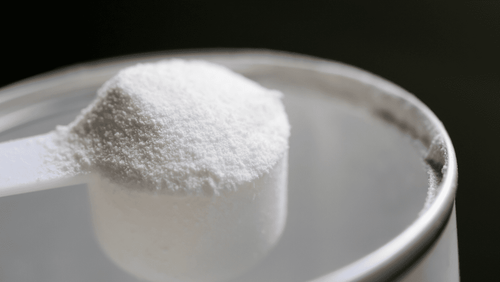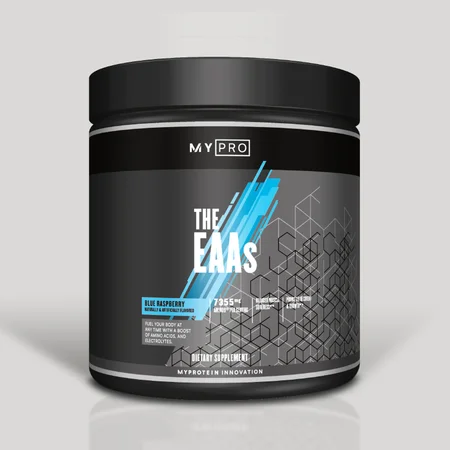Essential Amino Acids | Everything You Need To Know

Any nutritionist will tell you that protein is one of the most important nutrients for muscle-building success. What’s often not clocked by the average gym-goer is that high-quality protein is made up of all the essential amino acids.
Protein is very important for optimal body composition and is termed as an essential macronutrient. This means that the body can’t make protein, so it has to come through the diet.12 But what exactly are essential amino acids and do we need to supplement with them?
This article will cover the use of essential amino acids — how they work and who might benefit from them. Also, how to use them and if there are any potential side effects at all.
- Why do you need protein?
- What are amino acids?
- What are essential amino acids?
- The benefits of essential amino acids
- Why choose Impact EAAs?
- What’s the difference between EAAs and Impact Whey Protein?
- Suggested use for essential amino acids
- Essential amino acid side effects
Why do you need protein?
Whether your goals are to build muscle, lose weight, or just be healthier, you need to make sure that you’re eating enough high-quality protein on a daily basis to get there.8
The body also can’t store protein for later use, so it’s necessary to get the required amounts each day. Despite this, many people make the mistake of not getting enough protein each day, consistently throughout the week.
Protein has many different purposes in the body —including muscle growth, healthy immune function, and hormone production.1 Every time that you exercise or are physically active, proteins are involved in some manner.
Find out the optimal number of protein shakes here:

How Many Protein Shakes A Day is Healthy?
An experts advice on what you need, depending on your goals.
What are amino acids?
All of the protein we eat — whether it comes from meat or vegetable sources — is made up of amino acids. Amino acids are known as the building blocks of protein, and there are 20 different amino acids in total.12
There can be different combinations of amino acids in the food we eat, which in turn will affect the quality of the food and how the body uses them. Each amino acid has a very specific and unique role in the body.
The 20 amino acids can be broken down into two distinct categories: essential amino acids (EAAs) and non-essential amino acids (NEAAs).3

EAAs vs BCAAs | What Are The Differences? Do You Need Them?
EAAs and BCAAs made simple.
What are essential amino acids?
All proteins are made up of amino acids, and there are 9 essential amino acids in total. If the food you eat contains all of the 9 essential amino acids, then your body is able to make the other remaining 11 non-essential amino acids on its own.
This is the main difference between essential and non-essential amino acids. The body can’t make essential amino acids, but it can produce non-essential amino acids. That doesn’t mean that non-essential amino acids aren’t important for muscle building though.
When a food contains all 9 essential amino acids, then it’s known as a complete protein.2
The essential 9 amino acids are:
- Histidine — used to develop and maintain healthy tissue.
- Isoleucine — used for blood clotting and muscle repair.
- Leucine — branch chain amino acid involved in muscle growth.
- Lysine —involved in collagen production which is critical for healthy bones.
- Methionine — powerful antioxidant.
- Phenylalanine — helps produce stress and relaxation hormones.
- Threonine — used in the formation of bone and cartilage.
- Tryptophan — involved in inducing sleep as well as producing serotonin.
- Valine — helps prevent muscle breakdown and remove excess proteins from the liver.
Most of the amino acids that we eat get directed towards our muscles. One of the primary roles of essential amino acids is to look after lean muscle mass. This is done in two ways — it provides the building blocks to grow new muscle in a calorie surplus, and helps prevent muscle loss in a calorie deficit. 9

What are the benefits of essential amino acids?
Some of the benefits of consuming and supplementing with essential amino acids include:
Increased mitochondria production in cardiac and skeletal muscle (mitochondria are largely responsible for breaking down fatty acids and converting them to energy). This can be very useful for endurance athletes, as they will be able to break down more fatty acids to be used as fuel, which can improve performance and delay fatigue.4 Preventing oxidative damage which is linked to inflammation. When we train and exercise, it’s very normal for there to be a certain amount of damage. What we want to limit is excess inflammation and EAAs can potentially help to minimize this.4 Providing the signals and means to build new muscle. Essential amino acids have the ability to tell the body to start the process of building new muscle to cope with the stresses placed on it. Added to this, they provide the building blocks that the muscles need to grow. 13 Improving physical performance. Essential amino acids reduce fatigue under tension, which allows the body to work harder for longer. EAAs are involved in strength, muscle gain, and endurance improvements. 13 Reducing bodyweight. Essential amino acids help to mobilize fatty acids. They also contain few to no calories per gram, so they can be useful in creating a calorie deficit whilst maintaining lean muscle mass. 4 Improving immune function. Essential amino acids function as powerful antioxidants that help to keep the immune system strong. 4 Help prevent muscle protein breakdown. There are two parts to developing lean muscle tissue — the first is muscle growth and the second is preventing muscle breakdown. It’s been shown that essential amino acids help to combat unwanted muscle protein breakdown. 13

Why choose THE EAAs?
Not only does THE EAAs contain all the essential amino acids, it also contains an optimal 4:1:1 ratio of branch chain amino acids (BCAAs). These are leucine, isoleucine, and valine.
BCAAs have been shown to induce fat loss, promote muscle growth, and maintain overall exercise performance. That’s something we can get behind.
The 4:1:1 ratio of the branch chain is important because each amino acid has a different role:
- Leucine: the most important BCAA for protein creation and muscle growth. This is why there’s a higher ratio of it.
- Isoleucine: this BCAA boosts energy and recovery.
- Valine: repairs and maintains healthy muscles to keep you fighting fit.
What’s the difference between EAAs and Impact Whey Protein?
Both of these bestsellers have the same amino acid profile, so what’s the difference?
EAAs contain an added quantity of the BCAAs in the optimal ratios for muscle building. Music to our ears. Other than that, EAAs contain zero calories and zero sugar, unlike Impact Whey Protein. This is perfect for if you’re working towards a weight-loss goal or following a restricted-calorie diet.
EAAs are spot on for helping you to get the amino acids you need without needing to worry about the extra calories. And better yet, if you prefer a juicier shake it mixes to be more like juice than milky protein.
Essential amino acids dosage and suggested use
Essential amino acids don’t need to be digested, so a good time to take them is before and after your workout. They’re absorbed very quickly and are rapidly transported to the muscles to promote growth and recovery.
They can be used at any other time, perhaps when it’s difficult to eat a high-protein meal. However, they should still be seen as a supplement and not a substitute for whole foods.
When deciding how much to use, look up the nutritional information of that specific EAA supplement. You want to be getting roughly 3g of leucine per serving to get the best results for muscle growth and recovery. This is usually about 10g worth of essential amino acids.10

Essential amino acid side effects
You might be wondering whether it’s safe to supplement with essential amino acids, and if there are any risks. According to scientific research, there are no known serious side effects that have been reported when using an EAA supplement in both normal and high amounts.5
Take home message
Whether your goals are to get fit, lose weight, or put on muscle, protein should make up a significant part of your diet. Supplementing with essential amino acids gives a convenient and effective way to increase your daily protein intake, as well as provide a high-quality source of amino acids.
Essential amino acids won’t interfere with digestion, so are a great aid that can be taken before and after a workout for optimal growth and recovery.
Essential amino acids are suitable for all athletes with no known side effects, and can be used effectively as part of a well thought out nutrition plan.
FIND MORE ON SUPPLEMENTS HERE:

Casein Vs. Whey Protein | What's The Difference?
Whey? Casein? Both? Which should you choose?

Vegan Protein Powder | Best Vegan Alternatives To Whey Protein
Nutritionist unpacks your options.

What Is Collagen Protein | What Are The Benefits?
Could collagen be right for you?

- Alberts, B., Johnson, A., Lewis, J., Raff, M., Roberts, K., & Walter, P. (2002). Protein Function. Molecular Biology of the Cell. 4th Edition. Retrieved from https://www.ncbi.nlm.nih.gov/books/NBK26911/
- Allowances, N. R. C. (US) S. on the T. E. of the R. D. (1989). Protein and Amino Acids. National Academies Press (US). Retrieved from https://www.ncbi.nlm.nih.gov/books/NBK234922/
- Amino acids: MedlinePlus Medical Encyclopedia. (n.d.). Retrieved March 14, 2019, from https://medlineplus.gov/ency/article/002222.htm
- Bifari, F., Ruocco, C., Decimo, I., Fumagalli, G., Valerio, A., & Nisoli, E. (2017). Amino acid supplements and metabolic health: a potential interplay between intestinal microbiota and systems control. Genes & Nutrition, 12. https://doi.org/10.1186/s12263-017-0582-2
- Borack, M. S., & Volpi, E. (2016). Efficacy and Safety of Leucine Supplementation in the Elderly123. The Journal of Nutrition, 146(12), 2625S-2629S. https://doi.org/10.3945/jn.116.230771
- Dideriksen, K., Reitelseder, S., & Holm, L. (2013). Influence of Amino Acids, Dietary Protein, and Physical Activity on Muscle Mass Development in Humans. Nutrients, 5(3), 852–876. https://doi.org/10.3390/nu5030852
- Negro, M., Segreto, V., Barbero, M., Cescon, C., Castelli, L., Calanni, L., & D’Antona, G. (2018). Essential Amino Acids (EAA) Mixture Supplementation: Effects of an Acute Administration Protocol on Myoelectric Manifestations of Fatigue in the Biceps Brachii After Resistance Exercise. Frontiers in Physiology, 9. https://doi.org/10.3389/fphys.2018.01140
- Santarpia, L., Contaldo, F., & Pasanisi, F. (2017). Dietary protein content for an optimal diet: a clinical view. Journal of Cachexia, Sarcopenia and Muscle, 8(3), 345–348. https://doi.org/10.1002/jcsm.12176
- Volpi, E., Kobayashi, H., Sheffield-Moore, M., Mittendorfer, B., & Wolfe, R. R. (2003). Essential amino acids are primarily responsible for the amino acid stimulation of muscle protein anabolism in healthy elderly adults. The American Journal of Clinical Nutrition, 78(2), 250–258.
- Witard, O. C., Wardle, S. L., Macnaughton, L. S., Hodgson, A. B., & Tipton, K. D. (2016). Protein Considerations for Optimising Skeletal Muscle Mass in Healthy Young and Older Adults. Nutrients, 8(4). https://doi.org/10.3390/nu8040181
- Wu, G. (2010). Functional Amino Acids in Growth, Reproduction, and Health12. Advances in Nutrition, 1(1), 31–37. https://doi.org/10.3945/an.110.1008
- Wu, G. (2016). Dietary protein intake and human health. Food & Function, 7(3), 1251–1265. https://doi.org/10.1039/c5fo01530h
- Essential Amino Acids: Definition, Benefits and Food Sources. (2018, June 12). Retrieved March 19, 2019, from https://www.healthline.com/nutrition/essential-amino-acids








